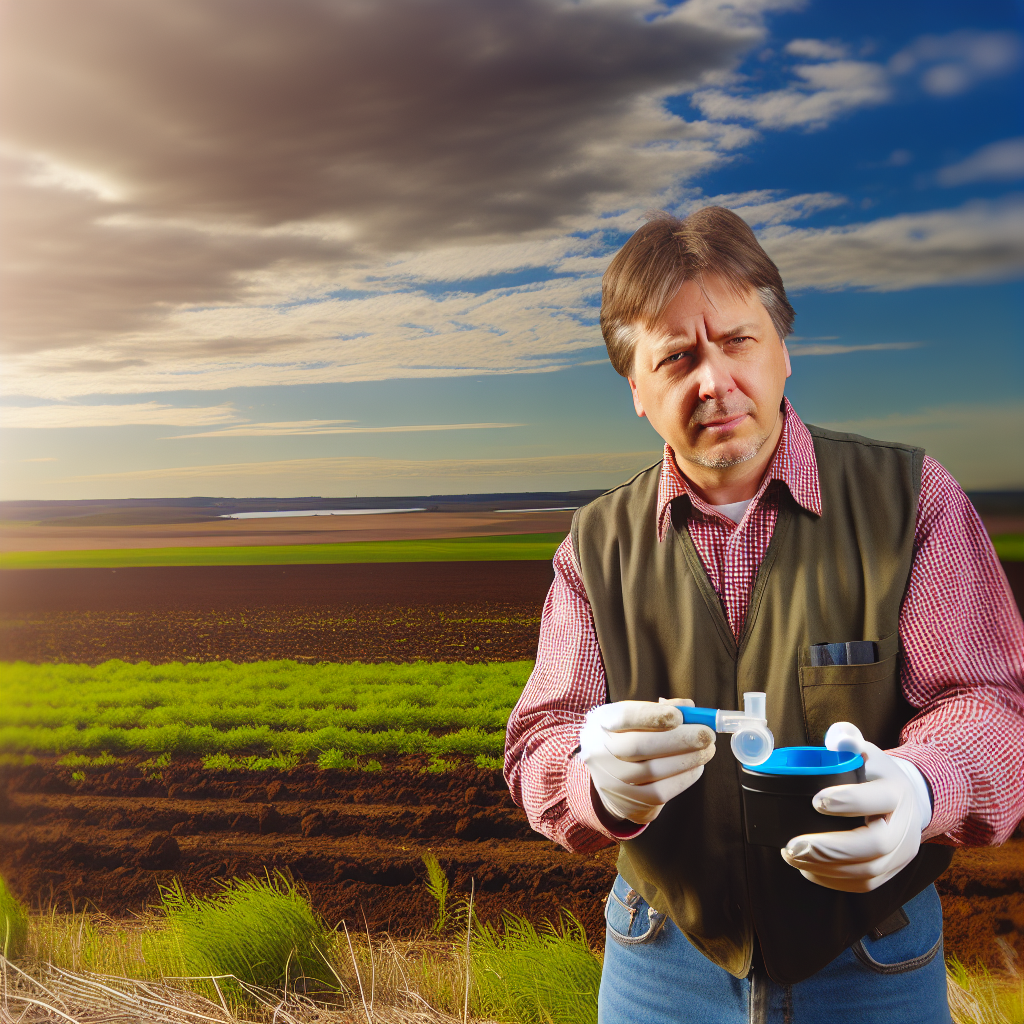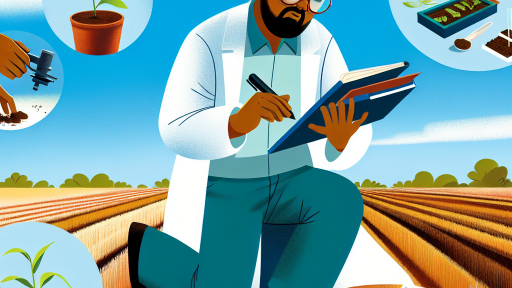Introduction to Soil Testing
Soil testing plays a crucial role in modern agriculture.
It helps farmers understand the nutrient composition of their soil.
With this information, they can make informed decisions.
This process ultimately leads to better crop yields.
Furthermore, soil testing helps identify potential issues.
For example, it can pinpoint deficiencies or toxicities in the soil.
Consequently, farmers can apply the right amendments accordingly.
Regular testing ensures that soil health is maintained over time.
This proactive approach helps prevent long-term damage.
Moreover, soil testing can save money on unnecessary fertilizers.
Farmers can allocate resources more effectively.
In addition to financial benefits, this method encourages sustainability.
Healthy soil supports robust plants and reduces chemical runoff.
By implementing soil testing, farmers can cultivate a better environment.
Ultimately, it contributes to sustainable farming practices.
Transform Your Agribusiness
Unlock your farm's potential with expert advice tailored to your needs. Get actionable steps that drive real results.
Get StartedSoil health translates to improved food quality for consumers.
Thus, soil testing is not just an option; it is essential for success.
Overview of Common Soil Testing Methods
Importance of Soil Testing
Soil testing plays a critical role in agriculture.
It helps farmers understand soil health and nutrient levels.
Additionally, it guides decisions on fertilization and crop selection.
As a result, proper soil management improves farm yields.
Visual Inspection
Visual inspection is a simple but valuable method.
Farmers can assess soil texture, color, and overall condition.
Moreover, they can identify signs of erosion or compaction.
This method requires no special equipment, making it accessible.
pH Testing
pH testing measures the acidity or alkalinity of the soil.
This measurement affects nutrient availability for crops.
Farmers typically use soil test kits for this purpose.
Consequently, they can make informed decisions on lime application.
Nutrient Analysis
Nutrient analysis evaluates essential soil nutrients.
Common nutrients tested include nitrogen, phosphorus, and potassium.
Labs use samples to determine nutrient levels accurately.
This information helps farmers tailor fertilizer applications.
Moisture Testing
Moisture testing gauges soil water content.
This is crucial for irrigation management.
Farmers can use moisture meters for real-time data.
Ultimately, this leads to more efficient water use.
Soil Texture Analysis
Soil texture analysis identifies the proportions of sand, silt, and clay.
This analysis influences drainage and fertility characteristics.
Showcase Your Farming Business
Publish your professional farming services profile on our blog for a one-time fee of $200 and reach a dedicated audience of farmers and agribusiness owners.
Publish Your ProfileFarmers can utilize soil texture kits for at-home testing.
As a result, they can select the best crops for their soil type.
Electrical Conductivity Testing
Electrical conductivity testing measures soil salinity.
Salinity levels can affect plant growth negatively.
Understanding these levels helps in proper management practices.
Farmers aim to reduce salinity for healthier plants.
Soil Testing Methods and Their Impacts
Each testing method provides valuable insights.
Farmers benefit from a comprehensive understanding of their soil.
Therefore, investing in soil testing leads to better farm yields.
Understanding Soil Composition
Importance of Soil Analysis
Soyl analysis provides vital information for farmers.
It helps in making informed decisions about crop management.
Additionally, understanding soil properties leads to better yields.
Understanding Soil pH
Soil pH indicates the acidity or alkalinity of the soil.
It directly influences nutrient availability for plants.
Most crops thrive in slightly acidic to neutral soils.
Regular testing helps in adjusting pH to optimal levels.
Nutrient Content
Nutrients play a crucial role in plant growth.
Essential nutrients include nitrogen, phosphorus, and potassium.
Testing reveals nutrient deficiencies or excesses in the soil.
Farmers can then tailor their fertilization strategies.
Organic Matter in Soil
Organic matter improves soil structure and fertility.
It enhances moisture retention and biological activity.
Testing focuses on the percentage of organic content present.
Increasing organic matter can significantly boost yields.
Methods of Soil Testing
There are various methods for testing soil composition.
Laboratory tests provide comprehensive and detailed results.
Home test kits offer a quick and simple alternative.
Regular soil testing is key to sustainable farming practices.
Uncover the Details: Using Biochar To Enhance Soil Fertility
Laboratory-Based Soil Testing: Procedures and Benefits
Overview of Laboratory-Based Soil Testing
Laboratory-based soil testing provides accurate and detailed analysis of soil samples.
This method offers a comprehensive understanding of soil health and nutrient levels.
Additionally, it enables farmers to make informed decisions about soil management.
Soil Sampling Techniques
Collecting soil samples correctly is vital for accurate testing.
First, choose multiple sampling spots to ensure a representative sample.
Next, use a clean soil probe or spade to collect soil from each spot.
Mix the samples together in a clean container for consistency.
Finally, let the samples dry and label them before sending them to the lab.
Laboratory Testing Procedures
Once received, laboratories conduct a series of tests on the soil samples.
Common tests include pH analysis, nutrient content, and texture evaluation.
Laboratories may also test for contaminants and organic matter levels.
Showcase Your Farming Business
Publish your professional farming services profile on our blog for a one-time fee of $200 and reach a dedicated audience of farmers and agribusiness owners.
Publish Your ProfileEach test provides valuable insights into soil conditions and health.
Benefits of Laboratory-Based Soil Testing
Laboratory-based testing offers numerous advantages for farmers.
First, it ensures precise recommendations for fertilizer application.
Furthermore, it helps identify nutrient deficiencies and toxicities.
This information is crucial for optimizing crop yields and soil health.
Additionally, it assists in developing effective soil management practices.
Interpreting Test Results
Understanding test results is essential for effective application.
Most laboratory reports provide clear instructions and guidance.
Farmers should pay attention to nutrient levels and pH recommendations.
Based on results, adjustments can be made to improve soil quality.
Cost Considerations
Cost is an important factor in choosing laboratory-based testing.
Investing in soil tests can lead to better yields and reduced input costs.
Farmers should consider the long-term financial benefits of accurate testing.
Ultimately, well-informed decisions can save money and improve productivity.
Maximizing Soil Management for Sustainable Yields
Laboratory-based soil testing is a vital tool for successful farming.
This method enhances understanding of soil health and productivity.
By utilizing the information gained, farmers can maximize their yields sustainably.
Learn More: Integrating Crop Diversity into Your Farming Practices
Field Tests: Quick Methods for On-Site Decision Making
Introduction to Field Testing
Field tests allow farmers to make quick decisions on-site.
These tests provide immediate feedback on soil conditions.
As a result, farmers can adjust practices to enhance yields.
Types of Field Tests
Several quick methods exist for conducting field tests.
Each method serves a specific purpose in soil analysis.
- pH testing
- Nutrient testing
- Moisture testing
- Soil texture analysis
pH Testing
pH levels indicate soil acidity or alkalinity.
Use commercially available pH test kits for accuracy.
Adjust soil amendments based on pH results.
Nutrient Testing
Nutrient tests assess the availability of essential elements.
Common nutrients include nitrogen, phosphorus, and potassium.
Apply fertilizers based on nutrient test recommendations.
Moisture Testing
Moisture levels affect plant growth directly.
Utilize soil moisture meters for real-time measurement.
This information helps in irrigation management decisions.
Soil Texture Analysis
Soil texture influences water retention and drainage.
Perform a simple feel test by hand for quick assessments.
Understanding texture aids in selecting appropriate crops.
Implementing Field Tests
Farmers should integrate field tests into their regular routines.
Consistency leads to better decision-making over time.
Document findings for future reference and analysis.
Maximizing Farm Productivity
Field tests are vital for maximizing farm productivity.
Through these methods, farmers can respond promptly to soil conditions.
Showcase Your Farming Business
Publish your professional farming services profile on our blog for a one-time fee of $200 and reach a dedicated audience of farmers and agribusiness owners.
Publish Your ProfileUltimately, they lead to enhanced crop yields and profitability.
Gain More Insights: Sustainable Farm Pathways And Access Planning Essentials
Best Practices for Soil Sampling
Timing for Soil Sampling
Proper timing is essential for effective soil sampling.
Spring offers a great opportunity for sampling before planting begins.
Alternatively, fall sampling allows for comprehensive nutrient evaluations after the growing season.
Always consider soil moisture, as dry conditions can impact sample quality.
Moreover, sampling during consistent weather patterns yields more accurate results.
Techniques for Soil Sampling
Using the right sampling technique is crucial for meaningful analysis.
Begin by using a systematic grid pattern to ensure representative sampling.
Next, collect samples at various depths, typically 6 to 8 inches.
Remember to avoid sampling near old root zones or in poorly drained areas.
Additionally, ensure cleanliness to prevent cross-contamination of samples.
Tools and Equipment
Utilizing appropriate tools can enhance sampling accuracy.
For example, use a soil auger or spade for effective sample collection.
Consider using a soil probe for consistent depth and ease of use.
Make sure to have clean containers for transporting collected samples.
Label each sample clearly to avoid mix-ups during analysis.
Interpreting Soil Test Results
Understanding soil test results is vital for decision-making.
Focus on key indicators such as pH, nitrogen, phosphorus, and potassium levels.
Consult a local agronomist for professional interpretation of results.
Compare your results with recommended levels for your specific crops.
Furthermore, use findings to tailor nutrient management practices effectively.
Discover More: Enhancing Crop Yields Through Biodiversity

Interpreting Soil Test Results: What Farmers Need to Know
Understanding Soil Test Results
Soi testing provides crucial insights for farmers.
It helps to determine nutrient levels in the soil.
Nutrient content affects crop yield significantly.
Farmers must understand these results clearly.
Key Soil Nutrients and Their Roles
Common nutrients tested include nitrogen, phosphorus, and potassium.
Nitrogen supports leaf growth and overall plant health.
Phosphorus promotes root development and flowering.
Potassium enhances drought resistance and overall hardiness.
pH Levels and Their Importance
Soil pH affects nutrient availability.
A pH level between 6.0 and 7.0 is ideal for most crops.
Farmers should adjust pH through amendments if necessary.
Liming can increase pH, while sulfur can decrease it.
Interpreting Soil Test Recommendations
Soil tests often come with specific recommendations.
Farmers should follow these guidelines closely.
Adjusting fertilizer applications can optimize yields.
Regular soil testing helps to track changes over time.
Common Mistakes to Avoid
Ignoring soil test results can lead to poor crop performance.
Showcase Your Farming Business
Publish your professional farming services profile on our blog for a one-time fee of $200 and reach a dedicated audience of farmers and agribusiness owners.
Publish Your ProfileOver-fertilization can cause nutrient runoff and pollution.
Under-fertilization may result in lower yields.
Farmers should consult with agronomists for professional advice.
Utilizing Soil Test Results Effectively
Farmers can implement soil test results into their management practices.
Using a precision farming approach enhances nutrient management.
Monitoring soil health regularly fosters sustainable farming practices.
Ultimately, effective soil management leads to improved farm yields.
Actionable Strategies Based on Soil Test Results
Understanding Soil Nutrient Levels
Soi tests reveal essential nutrient levels in your fields.
Regular testing helps you identify deficiencies promptly.
This knowledge allows for targeted fertilization strategies.
For example, consider adding nitrogen if low levels are detected.
Always compare results from different soil zones on your farm.
Adjusting pH Levels
Soi pH significantly affects nutrient availability.
Testing can show you whether your soil is too acidic or alkaline.
Use lime to raise pH levels and sulfur to lower them.
These amendments should be applied based on soil test results.
Improving Soil Structure
Soi testing assesses organic matter and soil texture.
Add organic materials like compost to enhance soil structure.
Additionally, cover crops can improve soil health.
Good soil structure enhances water retention and root development.
Implementing Crop Rotation Strategies
Soi tests provide insights into the best crops to plant next.
Rotate crops to prevent nutrient depletion.
This practice breaks pest and weed cycles effectively.
Use soil analysis to tailor your rotation plans each year.
Utilizing Precision Agriculture Techniques
Modern technology assists with interpreting soil test results.
Precision agriculture optimizes all inputs based on data.
Apply fertilizers and amendments only where needed.
This approach maximizes efficiency and minimizes waste.
Monitoring Soil Health Over Time
Continuous monitoring establishes long-term soil health trends.
Regular soil tests can help adjust management strategies gradually.
Analyze trends to understand how farming practices affect soil.
This knowledge leads to informed decisions and better yields.
Case Studies: Successful Soil Testing and Enhanced Crop Yields
Farmers Implementing Soil Testing
Farmers are increasingly adopting soil testing practices.
This shift allows them to understand the unique needs of their land.
For example, in Georgia, David Thompson used soil testing on his cornfields.
He tailored his fertilizer applications based on test results.
As a result, his corn yield increased by 25% over the previous season.
Innovative Approaches by Agricultural Companies
Several agricultural companies are leading the way in soil testing technology.
AgriTech Innovations developed a mobile app for farmers.
This app provides real-time soil analysis based on GPS data.
Showcase Your Farming Business
Publish your professional farming services profile on our blog for a one-time fee of $200 and reach a dedicated audience of farmers and agribusiness owners.
Publish Your ProfileFarmers using this app saw an average yield improvement of 30% in soybeans.
Such technologies make soil analysis accessible and actionable.
Educational Programs Enhancing Knowledge
Extension services are crucial in promoting soil testing awareness.
A program in Michigan teaches farmers the importance of soil health.
Participants learned to conduct soil tests effectively.
Feedback indicates farmers improved their yields by 15% within a year.
This highlights the importance of continuous education in agriculture.
Long-Term Impacts of Soil Testing
Successful soil testing creates lasting improvements in farming practices.
In Pennsylvania, Emma Wilson witnessed this firsthand.
After adopting regular soil testing, her farm became more sustainable.
She reduced chemical inputs and boosted organic matter in her soil.
Consequently, her crop resilience against pests and diseases improved.
Collaboration for Increased Success
Collaboration among farmers enhances learning and innovation.
In Iowa, a group of farmers formed a co-op dedicated to soil health.
This co-op shares soil testing results and strategies.
Ultimately, this collective knowledge leads to better farm yields across the board.
Such partnerships prove effective in maximizing agricultural efforts.
Additional Resources
Long-Term Evidence Shows that Crop-Rotation Diversification …




